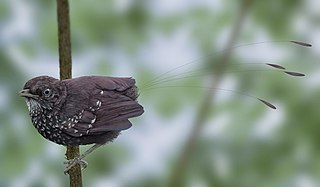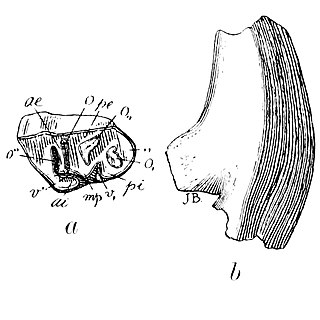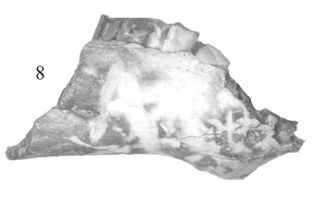
Thecodontosaurus is a genus of herbivorous basal sauropodomorph dinosaur that lived during the late Triassic period.

Interatheriidae is an extinct family of notoungulate mammals from South America. Interatheriids are known from the Middle Eocene (Mustersan) to the Early Pleistocene (Uquian). These animals were principally small-sized, occupying a habitat like hares, marmots and viscachas. The majority were very small, like rodents.

Interatherium is an extinct genus of interatheriid notoungulate from the Early to Middle Miocene (Colhuehuapian-Mayoan). Fossils have been found in the Santa Cruz, Collón Curá and Sarmiento Formations in Argentina.
Reigomys primigenus is an extinct oryzomyine rodent known from Pleistocene deposits in Tarija Department, southeastern Bolivia. It is known from a number of isolated jaws and molars which show that its molars were almost identical to those of the living Lundomys. On the other hand, the animal possesses a number of derived traits of the palate which document a closer relationship to living Holochilus, the genus of South American marsh rats, and for this reason it was placed in the genus Holochilus when it was first described in 1996. The subsequent discoveries of Noronhomys and Carletonomys, which may be more closely related to extant Holochilus than H. primigenus is, have cast its placement in Holochilus into doubt, and it was ultimately made the type species of a separate genus, Reigomys.

Atacamatitan is a genus of titanosaurian sauropod dinosaurs from the Late Cretaceous Tolar Formation of Chile.

Parvavis is a genus of enantiornithine bird, known from the upper Cretaceous of China in the Jiangdihe Formation. The type and only species, Parvavis chuxiongensis, was recovered in Luojumei Village, Chuxiong City, Yunnan Province, southern China, and it was the only known Mesozoic bird from south China at the time of its discovery. Based on its bone structure, the holotype was determined to be nearly fully grown at its time of death and would have been smaller than Iberomesornis, the smallest known enantiornithine prior to the description of Parvavis.
Transpithecus is an extinct genus of Notoungulates, belonging to the suborder Typotheria. It lived during the Middle Eocene in what is today South America.

Argyrohippus is an extinct genus of notoungulate, belonging to the family Notohippidae. It lived from the Late Oligocene to the Early Miocene, and its fossilized remains were found in South America.
Propachyrucos is an extinct genus of hegetotheriid notoungulate. It lived from the Late Oligocene to the Early Miocene, in what is today South America.
Antofagastia is an extinct genus of Notoungulate, belonging to the family Interatheriidae. It lived during the Late Eocene in what is today South America.
Johnbell is an extinct genus of ungulates, from the family Interatheriidae. The only known species belonging to the genus is Johnbell hatcheri. This animal was named after the paleontologist John Bell Hatcher. This genus is related to Ignigena and the subfamily Interatheriinae. This animal lived in central Chile during the Early Oligocene.
Juchuysillu is an extinct genus of interatheriid notoungulate. It lived from the Early to the Middle Miocene, and its fossils have been found in Bolivia.
Argyrohyrax is an extinct genus of interatheriid notoungulate that lived during the Late Oligocene, of what is now Argentina and Bolivia.
Patriarchus is an extinct genus of interatheriid notoungulates that lived during the Early Miocene in what is now Argentina. Fossils of this genus have been found in the Santa Cruz Formation of Argentina.
Santiagorothia is an extinct genus of interatheriid notoungulate. It lived during the Early Oligocene, and its fossils were discovered in Argentina and Chile.

Cochilius is an extinct genus of interatheriid notoungulate that lived between the Late Oligocene and the lower Miocene in what is now Argentina.

Notopithecus is an extinct genus of Notoungulate, belonging to the suborder Typotheria. It lived from the Middle to the Late Eocene and its fossilized remains were discovered in South America.
Chasicobradys is an extinct genus of ground sloths of the family Nothrotheriidae that lived in what is now Argentina. Chasicobradys was discovered in the Arroyo Chasicó Formation, in Buenos Aires Province. It is only known from jaw fragments and teeth, which allowed the identification of this species, and was classified as a member of the nothrotheriid subfamily Nothrotheriinae, which comprises small to medium-sized species of ground sloths.

Eopachyrucos is an extinct genus of interatheriid notoungulates that lived from the Middle Eocene to the Late Oligocene of Argentina and Uruguay. Fossils of this genus have been found in the Sarmiento Formation of Argentina and the Fray Bentos Formation of Uruguay.

Proargyrohyrax is an extinct genus of interatheriine notoungulates that lived from the Early to Middle Oligocene in what is now Argentina. Fossils of this genus have been found in the Sarmiento Formation of Argentina.

















